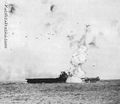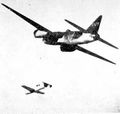Kamikaze
Kamikaze (Japanese for "Divine Wind") refers to a kind of attack in which a pilot crashes the vehicle he is operating at high speed into an enemy ship or position. Kamikaze attacks were used by the Empire of Japan during the last phase of the Second World War as a desperation move against the numerically superior United States Navy and Royal Australian Navy forces, and they were essentially the first guided missiles. While these attacks were somewhat successful in destroying ships, it was not enough to stop allied efforts.
The kamikazes included not only standard aircraft but also specially designed, rocket-powered guided missiles (ohka) and -- on the ocean -- specially designed piloted torpedoes (kaiten). Neither of these specialized suicide vehicles was particularly effective due to the vulnerability of the bombers and submarines that the weapons required to deliver them to within range of their targets. However, whenever they were able to make a successful attack, the results were spectacular.
Such attacks were not just limited to the Japanese, as there was at least one German Operation, the Sonderkommando Elbe, where 180 Bf 109 fighters (first attack of the 2000 strong force) took part in a ramming attack on the US Eighth Airforce's bombers on 7 April 1945. This attack had only very limited effectiveness so all future Sonderkommando Elbe missions were cancelled. Only 13 successful attacks were performed that day with those only downing 12 American bombers and damaging 3 others forcing them to retreat. Unlike the Japanese kamikaze attacks, these were not intended as suicide attacks; the pilots were told to try to bail out once they had completed a successful ramming attack. Of the 13 pilots, only 5 survived.
Kamikaze attacks in Science Fiction
- Wraith Darts will Kamikaze into targets if left without a carrier vessel.
- Jem'Hadar attack ships will ram into enemy ships with little provocation.








